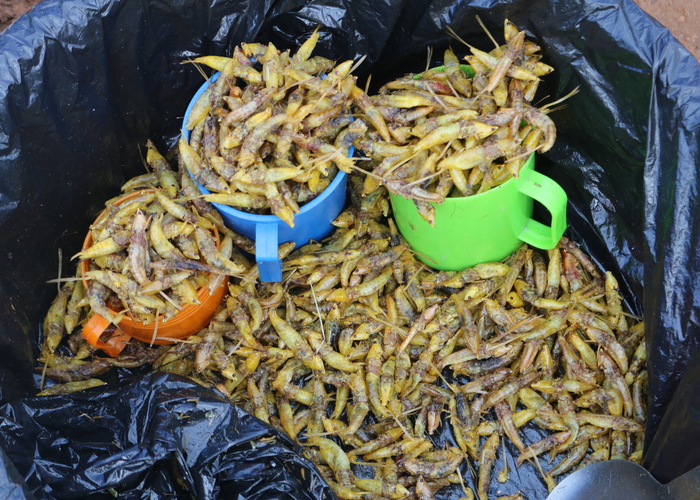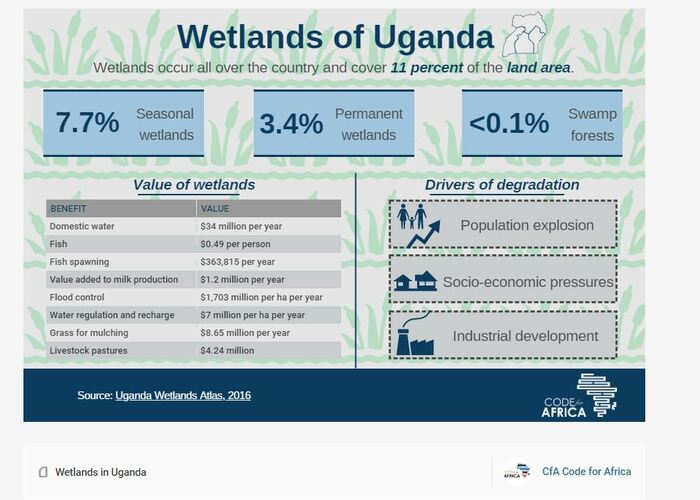The decline in insect populations worry East Africans
The national environment agency – NEMA says the major reasons why the southwestern region and other regions in Uganda no longer receive grasshoppers in big numbers are: change in climate and wetlands’ destruction.
By Fredrick Mugira in Uganda and Jacob Mugini in Tanzania
In the not so distant past, it would have been hard to convince Josephine Kateeba, a housewife in Rwentobo, Rugando Rwampara district in southwestern Uganda to buy grasshoppers, let alone spending a whole year without eating some.
For her family and several other homesteads in her community, grasshoppers were free. Women and children would catch them in bushes from November to December and April to June seasons. But things have changed now.
"They are no more!" notes Josephine further narrating that, "we now buy them in towns like other goods."
Disappearing grasshoppers in Uganda
Grasshoppers are a delicacy in Uganda. They are eaten by most people in central and western regions. In the past, they used to come in big numbers in past. They are however scarce and unpredictable now.
"I would trap over 100 sacks of grasshoppers on a good day. But I only trapped three sacks in April (this year) on my lucky day," laments Gordon Kahimbise, a commercial grasshoppers trapper in Mbarara town, Uganda.
The national environment agency - NEMA says the major reasons why the southwestern region and other regions in Uganda no longer receive grasshoppers in big numbers are: change in climate and wetlands' destruction.

"Grasshoppers normally lay eggs in lake shores. Their eggs need optimum warmth of the sand to hatch," narrates Jeconious Musingwire, an environmental scientist and NEMA's manager for southwestern Uganda.
He says "intensive rains and high temperatures," as a result of climate change, "are affecting the hatching process and the rate of multiplication," of grasshoppers.
But also dry spells and wetlands destruction is affecting the vegetation cover which grasshoppers depend on for growth. "Wetlands have a direct correlation with the maturity of grasshoppers. They hide there up to the time when they become nymphs so they can fly off and look for food elsewhere. If the vegetation in neighborhood of lakeshores is destroyed, the life cycle of grasshoppers is also affected," narrates Musingwire.
Wetlands covered 13 percent of Uganda's total land in 1986. This has been reduced to just 9.8 percent now according to NEMA.
Disappearing butterflies in Mara Tanzania
Butterflies and grasshoppers have almost the same life cycle. They are more in wetlands than any other place. In Tanzania, Butterflies are disappearing from the Mara River wetlands and local communities are missing the migration of these beautiful insects.
"Forests along the river banks have been badly damaged and for that reason, insects are disappearing," says Kanuni Kanuni, an environmental expert who works with World Wide Fund for Nature (WWF) Tanzania at Mara River Basin office in Musoma.
Mara River is a trans-boundary river which forms an integral part of the Serengeti-Masai Mara ecosystem in Tanzania and Kenya. Recently, Kenyan media reported that Mara River is drying up, blaming it on sand harvesting, deforestation, and encroachment on the Mau forest.

Besides human activities, environmental experts in Kenya and Tanzania say climate change remains another threat to the river basin, covering 13,750 square kilometres.
Intensive agriculture alongside the river banks continues to change the landscape and could be the main factor contributing to the disappearance of butterflies from the Mara River wetlands.
"In the past, we used to see swarms of butterflies moving from one point to another and this was one of the tourist attractions but they are no longer seen nowadays. You have to look for them but they are rarely seen, not even in small numbers,'' says Mairi Mugabe, a resident of Kwisaro village.
Insect Apocalypse
Climate change includes the change in the vegetation. A change in vegetation would greatly affect insects that survive on grass.
Dr. Devolent Tomas Mtui of Tanzania Wildlife Research Institute says tropical species are predicted to be especially sensitive to climate change because "they are believed to have narrower ecological niches and elevational ranges."
A study published in the Biological Conservation shows that over 40 % of insect species are threatened worldwide with intensive agriculture and climate change cited to be the main contributing factors.
Professor Kenneth Irvine of IHE Delft in the Netherlands warns that the situation may be critical in 2025. " Insects are important in the way the planet works and tell about the quality of water," Prof Irvine said in February this year on part of his presentation during a media, science, and water journalism training workshop attended by about 20 science journalists from Nile basin countries.
What happens to communities when insects disappear?
In the Mara region, the disappearance of insects could compromise the health of the Mara River, according to scientists. "Ecologically, insects are very important and are also used to assess the health of Mara River, very often, "Kanuni says.
"For example, we use dragonflies to assess the health of rivers. A healthy river involves water flow. The presence of many insects symbolizes a healthy river," he adds.
In southwestern Uganda, the disappearance of grasshoppers is already forcing communities to spend money to buy grasshoppers they never used to buy. A half-liter cup of grasshoppers cost 10,000 Uganda shillings in April, up from 3,000 shillings in December last year when they were in plenty.
The worst effect could be the disappearance of pollinators. Pollinators such as butterflies and bees guide the flowering plants. In the search of nectar, pollinators transfer pollen from flower to flower. Pollen is essential for the reproduction of most flowers. In Uganda for example, environmentalists are worried that in five years to come, the production of coffee could be impaired due to the scarcity of bees.
Insects adapting to climate change
As a move to adapt to rising temperatures in their habitats, insects are having to move to higher altitudes. Other studies have suggested that tropical insects are moving away from the tropic region at a rate of about two miles annually.
"In the long run we are predicting flower‐pollinating butterfly species have shifted their elevational ranges upslope," notes Dr. Devolent Tomas Mtui of Tanzania Wildlife Research Institute.
Serengeti Wildlife Research Centre (SWRC) Director Dr. Robert Fyumagwa says the insects in the Mara region might have shifted to other areas where a friendly climate favors their survival.
"It is possible that the insects in the Mara River basin have not disappeared but rather moved to cold areas," notes Dr. Fyumagwa, citing the example of, "some butterflies (that) have migrated from Kihansi in Kilombero basin due to high temperatures."
He, however, stresses that there is a need for scientific study to back this.
There is a thin line between adaptation and extinction. Some insects could be dying off in an attempt to adapt to climate change.
Changing color to survive
In Uganda, grasshoppers occur dominantly in green, brown and purple colors although there are several other colors. Grasshopper trappers in several parts of southwestern Uganda reported an increase in brown-colored grasshoppers compared to the green ones.
Some experts have argued that this could be linked to increased dry vegetation. Citing Prof William Banage, Nature Uganda notes on one of its web pages that the different color forms for grasshoppers are for protection.
"The green ones mimic the green vegetation, brown - dry vegetation and purple - dying grass," writes Nature Uganda.
If this is true, the increase in brown grasshoppers could suggest an increase in dry vegetation. There are several factors responsible for the drying of vegetation. Climate change is one of them.
Breeding of insects for food and conservation purposes
Researchers at Makerere University are in initial stages of breeding grasshoppers to make them available all year and a bit affordable.
The INSBIZ project (INSect- based agriBIZness for sustainable grasshopper and cricket production and processing for food in Kenya and Uganda) was launched last year. It is now at the research level.
"We are trying to scale up but it is still at the research level," narrates Dr. Dorothy Nakimbugwe, the Project Manager, also a lecturer in the Department of Food Technology and Human Nutrition at Makerere University. She says this project could in future guarantee grasshoppers all year around.
"There are months of the year when people would like to eat grasshoppers but can't access them. So we want to feel that gap," she notes. Mass breeding of insects could be part of a sustainable lasting solution to prevent insects' extinction.
This work was produced as a result of a grant provided by IHE Delft Global Partnership for Water and Development through Water Journalists Africa network.